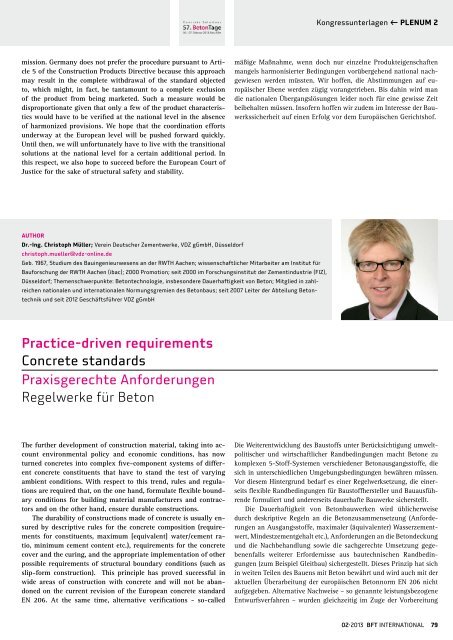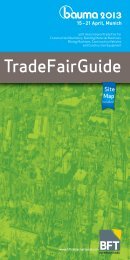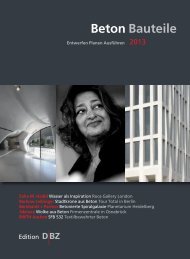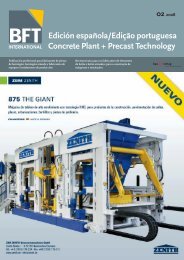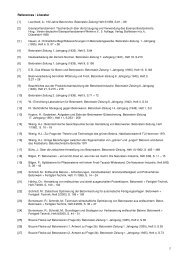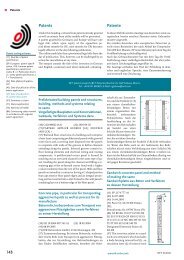KONGRESSUNTERLAGEN | PROCEEDINGS - Bft-international.com
KONGRESSUNTERLAGEN | PROCEEDINGS - Bft-international.com
KONGRESSUNTERLAGEN | PROCEEDINGS - Bft-international.com
Sie wollen auch ein ePaper? Erhöhen Sie die Reichweite Ihrer Titel.
YUMPU macht aus Druck-PDFs automatisch weboptimierte ePaper, die Google liebt.
Kongressunterlagen ← PLENUM 2<br />
mission. Germany does not prefer the procedure pursuant to Article<br />
5 of the Construction Products Directive because this approach<br />
may result in the <strong>com</strong>plete withdrawal of the standard objected<br />
to, which might, in fact, be tantamount to a <strong>com</strong>plete exclusion<br />
of the product from being marketed. Such a measure would be<br />
disproportionate given that only a few of the product characteristics<br />
would have to be verified at the national level in the absence<br />
of harmonized provisions. We hope that the coordination efforts<br />
underway at the European level will be pushed forward quickly.<br />
Until then, we will unfortunately have to live with the transitional<br />
solutions at the national level for a certain additional period. In<br />
this respect, we also hope to succeed before the European Court of<br />
Justice for the sake of structural safety and stability.<br />
mäßige Maßnahme, wenn doch nur einzelne Produkteigenschaften<br />
mangels harmonisierter Bedingungen vorübergehend national nachgewiesen<br />
werden müssten. Wir hoffen, die Abstimmungen auf europäischer<br />
Ebene werden zügig vorangetrieben. Bis dahin wird man<br />
die nationalen Übergangslösungen leider noch für eine gewisse Zeit<br />
beibehalten müssen. Insofern hoffen wir zudem im Interesse der Bauwerkssicherheit<br />
auf einen Erfolg vor dem Europäischen Gerichtshof.<br />
AUTHOR<br />
Dr.-Ing. Christoph Müller; Verein Deutscher Zementwerke, VDZ gGmbH, Düsseldorf<br />
christoph.mueller@vdz-online.de<br />
Geb. 1967, Studium des Bauingenieurwesens an der RWTH Aachen; wissenschaftlicher Mitarbeiter am Institut für<br />
Bauforschung der RWTH Aachen (ibac); 2000 Promotion; seit 2000 im Forschungsinstitut der Zementindustrie (FIZ),<br />
Düsseldorf; Themenschwerpunkte: Betontechnologie, insbesondere Dauerhaftigkeit von Beton; Mitglied in zahlreichen<br />
nationalen und <strong>international</strong>en Normungsgremien des Betonbaus; seit 2007 Leiter der Abteilung Betontechnik<br />
und seit 2012 Geschäftsführer VDZ gGmbH<br />
Practice-driven requirements<br />
Concrete standards<br />
Praxisgerechte Anforderungen<br />
Regelwerke für Beton<br />
The further development of construction material, taking into account<br />
environmental policy and economic conditions, has now<br />
turned concretes into <strong>com</strong>plex five-<strong>com</strong>ponent systems of different<br />
concrete constituents that have to stand the test of varying<br />
ambient conditions. With respect to this trend, rules and regulations<br />
are required that, on the one hand, formulate flexible boundary<br />
conditions for building material manufacturers and contractors<br />
and on the other hand, ensure durable constructions.<br />
The durability of constructions made of concrete is usually ensured<br />
by descriptive rules for the concrete <strong>com</strong>position (requirements<br />
for constituents, maximum [equivalent] water/cement ratio,<br />
minimum cement content etc.), requirements for the concrete<br />
cover and the curing, and the appropriate implementation of other<br />
possible requirements of structural boundary conditions (such as<br />
slip-form construction). This principle has proved successful in<br />
wide areas of construction with concrete and will not be abandoned<br />
on the current revision of the European concrete standard<br />
EN 206. At the same time, alternative verifications - so-called<br />
Die Weiterentwicklung des Baustoffs unter Berücksichtigung umweltpolitischer<br />
und wirtschaftlicher Randbedingungen macht Betone zu<br />
komplexen 5-Stoff-Systemen verschiedener Betonausgangsstoffe, die<br />
sich in unterschiedlichen Umgebungsbedingungen bewähren müssen.<br />
Vor diesem Hintergrund bedarf es einer Regelwerksetzung, die einerseits<br />
flexible Randbedingungen für Baustoffhersteller und Bauausführende<br />
formuliert und andererseits dauerhafte Bauwerke sicherstellt.<br />
Die Dauerhaftigkeit von Betonbauwerken wird üblicherweise<br />
durch deskriptive Regeln an die Betonzusammensetzung (Anforderungen<br />
an Ausgangsstoffe, maximaler (äquivalenter) Wasserzementwert,<br />
Mindestzementgehalt etc.), Anforderungen an die Betondeckung<br />
und die Nachbehandlung sowie die sachgerechte Umsetzung gegebenenfalls<br />
weiterer Erfordernisse aus bautechnischen Randbedingungen<br />
(zum Beispiel Gleitbau) sichergestellt. Dieses Prinzip hat sich<br />
in weiten Teilen des Bauens mit Beton bewährt und wird auch mit der<br />
aktuellen Überarbeitung der europäischen Betonnorm EN 206 nicht<br />
aufgegeben. Alternative Nachweise – so genannte leistungsbezogene<br />
Entwurfsverfahren – wurden gleichzeitig im Zuge der Vorbereitung<br />
02·2013 BFT INTERNATIONAL 79


